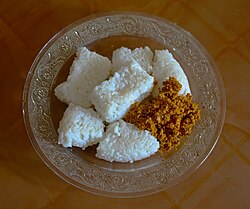Kiribath
 Kiribath | |
| Alternative names | කිරිබත්, Milk rice |
|---|---|
| Course | Breakfast, Main dish |
| Place of origin | Sri Lanka |
| Associated cuisine | Sri Lankan cuisine |
| Cooking time | 50 minutes to 1 hour 20 min |
| Main ingredients | Rice, coconut milk |
| Ingredients generally used | Salt |
| Variations | Mun Kiribath, Imbul kiribath |
| Similar dishes | Coconut rice |
Kiribath (Sinhala: කිරිබත්) is a traditional Sri Lankan dish made from rice. It is prepared by cooking rice with coconut milk, hence this name, and can be considered a form of rice cake or rice pudding.[1] Kiribath is an essential dish in Sri Lankan cuisine. It is very commonly served for breakfast on the first day of each month and also has the added significance of being eaten for any auspicious moment throughout one's lifetime which are marking times of transition.[2][3] It is one of the more renowned traditional dishes in Sri Lanka.[4]
Etymology
The word is a
History
The origins of kiribath are not clear, although the dish seems to be unique to Sri Lanka.[5]
It is said that
Occasions
In a Sinhalese home, and during Sinhalese holidays and ceremonies kiribath plays a significant role. The dish celebrates festive or auspicious occasions and symbolises the beginning of new pursuits or transitions in life.[6] Traditionally it is also eaten by families on the first day of each month.[7]
New Year
Kiribath has a very important role for the Sinhalese in celebrating the
Feeding ceremony
Kiribath is traditionally the first solid food fed to an infant.[11][6][7]
Weddings
Kiribath is fed by bridegrooms to brides at their wedding.[6][7]
Ingredients and preparation

- Ingredients
Kiribath is typically prepared from four basic components: white short-grain rice, thick coconut milk or basic milk, water and salt to taste.[6]
It is made from starchy and sticky rice, traditionally a variety known as rathu haal or rathu kakulu haal for its neutral flavour and cooking qualities.
- Preparation
The rice is cooked in
- Consumption
Kiribath is usually served with
Although served onto the plate with a spoon, kiribath is traditionally eaten by hand to mix with the lunumiris.[13]
Variations
There are variations of kiribath including:
Mung kiribath
Mung kiribath (Sinhala: මුං කිරිබත්) is a variation of Kiribath is made by adding boiled green gram to the milk rice. The same recipe and procedure can be followed to make this variation. It is often prepared in Buddhist temples.[6]
Imbul kiribath
Imbul kiribath (Sinhala: ඉඹුල් කිරිබත්) is a sweet variation of the original. It is made by taking a small amount of milk rice, made in the regular process, and spreading it on a banana leaf. A sweet filling made of coconut and jaggery, called Pani pol, is placed in the center. The banana leaf is folded and rolled vertically and pressed firm giving it its unusual cylindrical shape.[6][12]
See also
References
- ^ "Sri Lanka: Food & Tropical Fruits". lankalibrary.com. Retrieved 2008-09-13.
- ^ "Culture of SRI LANKA". everyculture.com. Retrieved 2008-09-13.
- ^ a b "Milk Rice (Kiribath) – A Sri Lankan Tradition". A Hazelnut For My Gypsy Heart. Archived from the original on 2 June 2020. Retrieved 27 July 2018.
- ^ "Sinhalese New Year Festival". info.lk. Archived from the original on 2008-07-04. Retrieved 2008-09-13.
- ^ Jaufer, Aaysha (23 January 2017). "What Makes A Sri Lankan Meal So Distinctive?". Retrieved 27 July 2018.
- ^ a b c d e f g h i Ramesh, Nisha (16 February 2018). "SRI LANKA: KIRIBATH". 196 Flavors. Retrieved 27 July 2018.
- ^ a b c d "Easy to make Milk Rice (Kiribath) in a rice cooker". Ammis Kitchen. 4 September 2015. Retrieved 27 July 2018.
- ISBN 9780313350665.
- ^ Wijesiri, Lionel. "Preserving Avurudu traditions, a prime responsibility". Daily news. Retrieved 27 July 2018.
- ^ Van Daele, Wim. "The meaning of culture-specific food: rice and its webs of significance in Sri Lanka" (PDF). Journal of Applied Anthropology: 292–304. Retrieved 27 July 2018.
- ISBN 9781407081342.
- ^ a b "Everything You Need to Know About Sri Lankan Kiribath". THE FOODIE MILES. 18 July 2016. Retrieved 27 July 2018.
- ^ "How to make Kiribath (Sri Lankan Milk Rice)". Island smile. 3 January 2017. Retrieved 27 July 2018.
